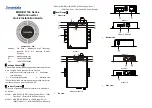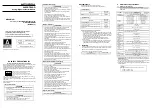
14
Chapter 3
How to Install and Connect Converter
3.1.
Installation Environment and How to Install
3.1.1.
Installation Environment
Install the converter in an environment not exceeding the overvoltage category III or the pollution degree 2
defined by the IEC60664-1.
Overvoltage category
Overvoltage
category
Equipment
Equipment overview
I
Secondary circuit
Equipment connecting to a circuit where any measures are taken to
limit transient overvoltage to a lower level. It includes a
protected electronic circuit.
II
Home electrical appliance
and office machine
Equipment consuming energy supplied from a fixed wiring facility.
III
Electrical facility
Equipment in the fixed wiring facility which especially requires
reliability and effectiveness.
IV
Power receiving
Equipment used for a service entrance.
Pollution degree
Pollution
degree
Overview
Specific example
1
There is no pollution, or only dry and non-conductive pollution
occurs. This type of pollution has no effect.
Clean room and others
2
Typically, only non-conductive pollution occurs. However, when the
system is not running, temporary conductivity can be expected due
to condensation.
Electrical equipment in
an office and a control
panel, and others
3
Conductive pollution, or dry and non-conductive pollution resulting
in conductivity due to expected condensation occurs.
In a general factory and
others
4
Pollution causes continuous conductivity due to conductive dust,
rain, and snow.
Outdoor and others
3.1.2.
How to Install Converter
■
Requirements of where to install the converter
Installation conditions of the converter will greatly affect its life and reliability. Avoid installing it in
the places listed below. Use it under the environmental conditions described in {Chapter 9 Standard
Specifications}.
(1) In a humid and dusty area or a place where water or oil drips, the insulation of circuits is deteriorated,
which may reduce the life of parts.
(2) Too high ambient temperature will cause the life of the main circuit capacitor or the cooling fan to be
reduced.
(3) In a place containing corrosive gas, connectors may have a loose connection, electrical wires may be
disconnected, and parts may be damaged.















































